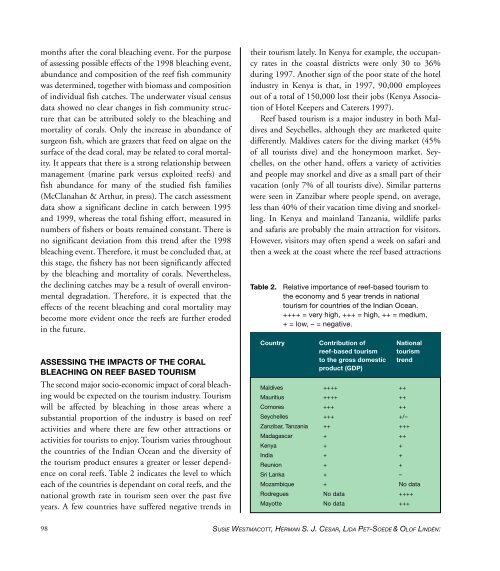Create successful ePaper yourself
Turn your PDF publications into a flip-book with our unique Google optimized e-Paper software.
months after the coral bleaching event. For the purpose<br />
<strong>of</strong> assessing possible effects <strong>of</strong> the 1998 bleaching event,<br />
abundance and composition <strong>of</strong> the reef fish community<br />
was determined, together with biomass and composition<br />
<strong>of</strong> individual fish catches. The underwater visual census<br />
data showed no clear changes in fish community structure<br />
that can be attributed solely to the bleaching and<br />
mortality <strong>of</strong> corals. Only the increase in abundance <strong>of</strong><br />
surgeon fish, which are grazers that feed on algae on the<br />
surface <strong>of</strong> the dead coral, may be related to coral mortality.<br />
It appears that there is a strong relationship between<br />
management (marine park versus exploited reefs) and<br />
fish abundance for many <strong>of</strong> the studied fish families<br />
(McClanahan & Arthur, in press). The catch assessment<br />
data show a significant decline in catch between 1995<br />
and 1999, whereas the total fishing effort, measured in<br />
numbers <strong>of</strong> fishers or boats remained constant. There is<br />
no significant deviation from this trend after the 1998<br />
bleaching event. Therefore, it must be concluded that, at<br />
this stage, the fishery has not been significantly affected<br />
by the bleaching and mortality <strong>of</strong> corals. Nevertheless,<br />
the declining catches may be a result <strong>of</strong> overall environmental<br />
degradation. Therefore, it is expected that the<br />
effects <strong>of</strong> the recent bleaching and coral mortality may<br />
become more evident once the reefs are further eroded<br />
in the future.<br />
ASSESSING THE IMPACTS OF THE CORAL<br />
BLEACHING ON REEF BASED TOURISM<br />
The second major socio-economic impact <strong>of</strong> coral bleaching<br />
would be expected on the tourism industry. Tourism<br />
will be affected by bleaching in those areas where a<br />
substantial proportion <strong>of</strong> the industry is based on reef<br />
activities and where there are few other attractions or<br />
activities for tourists to enjoy. Tourism varies throughout<br />
the countries <strong>of</strong> the Indian Ocean and the diversity <strong>of</strong><br />
the tourism product ensures a greater or lesser dependence<br />
on coral reefs. Table 2 indicates the level to which<br />
each <strong>of</strong> the countries is dependant on coral reefs, and the<br />
national growth rate in tourism seen over the past five<br />
years. A few countries have suffered negative trends in<br />
their tourism lately. In Kenya for example, the occupancy<br />
rates in the coastal districts were only 30 to 36%<br />
during 1997. Another sign <strong>of</strong> the poor state <strong>of</strong> the hotel<br />
industry in Kenya is that, in 1997, 90,000 employees<br />
out <strong>of</strong> a total <strong>of</strong> 150,000 lost their jobs (Kenya Association<br />
<strong>of</strong> Hotel Keepers and Caterers 1997).<br />
Reef based tourism is a major industry in both Maldives<br />
and Seychelles, although they are marketed quite<br />
differently. Maldives caters for the diving market (45%<br />
<strong>of</strong> all tourists dive) and the honeymoon market. Seychelles,<br />
on the other hand, <strong>of</strong>fers a variety <strong>of</strong> activities<br />
and people may snorkel and dive as a small part <strong>of</strong> their<br />
vacation (only 7% <strong>of</strong> all tourists dive). Similar patterns<br />
were seen in Zanzibar where people spend, on average,<br />
less than 40% <strong>of</strong> their vacation time diving and snorkelling.<br />
In Kenya and mainland Tanzania, wildlife parks<br />
and safaris are probably the main attraction for visitors.<br />
However, visitors may <strong>of</strong>ten spend a week on safari and<br />
then a week at the coast where the reef based attractions<br />
Table 2.<br />
Relative importance <strong>of</strong> reef-based tourism to<br />
the economy and 5 year trends in national<br />
tourism for countries <strong>of</strong> the Indian Ocean.<br />
++++ = very high, +++ = high, ++ = medium,<br />
+ = low, – = negative.<br />
Country Contribution <strong>of</strong> National<br />
reef-based tourism tourism<br />
to the gross domestic trend<br />
product (GDP)<br />
Maldives ++++ ++<br />
Mauritius ++++ ++<br />
Comores +++ ++<br />
Seychelles +++ +/–<br />
Zanzibar, Tanzania ++ +++<br />
Madagascar + ++<br />
Kenya + +<br />
India + +<br />
Reunion + +<br />
Sri Lanka + –<br />
Mozambique + No data<br />
Rodregues No data ++++<br />
Mayotte No data +++<br />
98<br />
SUSIE WESTMACOTT, HERMAN S. J. CESAR, LIDA PET-SOEDE & OLOF LINDÉN:


















